- 1Institute of Ecological Conservation and Restoration, Chinese Academy of Forestry/Grassland Research Center, National Forestry and Grassland Administration, Beijing, China
- 2Henan Xiaolangdi Forest Ecosystem National Observation and Research Station, Jiyuan, China
- 3PowerChina Guiyang Engineering Corporation Limited, Guiyang, China
- 4College of Forestry, Guizhou University, Guiyang, China
Drip irrigation, a widely adopted water-saving technique, has received limited attention regarding its indirect effects on soil erosion. This study investigates soil erosion characteristics at varying intervals following drip irrigation using simulated rainfall experiments and an unirrigated control (S0) subjected to identical rainfall simulation procedures. The results showed significant hydrological differences between drip-irrigated and unirrigated treatments. Irrigated soils exhibited reduced runoff (mean reduction = 23.19%; p < 0.05) and sediment yield (mean reduction = 24.33%; p < 0.05) compared to S0, except for runoff in S24. Erosion mitigation was attributed to enhanced rainwater retention via surface irrigation-formed crusts and desiccation cracks generated during extended drying periods. These results highlight a previously under-characterized interaction between water-saving irrigation practices and soil erosion processes. The temporal evolution of soil surface characteristics following drip irrigation appears to influence hydrological responses during subsequent precipitation events, providing new insights for optimizing irrigation strategies in erosion-prone situations.
1 Introduction
Drip irrigation is a water-saving irrigation technology that provides precise and highly efficient delivery of water and nutrients to crops (Evans and Zaitchik, 2008; van Donk and Shaver, 2016). It is commonly assumed that drip irrigation does not generate surface runoff, thereby mitigating soil erosion. To a significant extent, this method has addressed the issue of water scarcity for crops in arid and semi-arid regions (Yahyaoui et al., 2016; Zhang et al., 2017). Furthermore, drip irrigation has been employed in various regions to resolve the spatial and temporal imbalances between natural precipitation and crop water requirements (Khan et al., 2008; Beser et al., 2016; Yang et al., 2023). For example, it has been utilized to counteract seasonal droughts in agriculture (Xiao et al., 2008; Singh et al., 2009; Stark et al., 2013) and support vegetation rehabilitation and restoration in degraded lands and extremely arid environments (Li et al., 2015; Al-Ghobari and Dewidar, 2018). As such, drip irrigation offers a valuable means of optimizing the use of agricultural land and water resources (Najafabadi et al., 2023).
Although drip irrigation differs from rainfall in that it avoids generating surface runoff and thus does not directly induce soil erosion, its implementation introduces unique surface characteristics. During drip irrigation, a wet circular area forms on the surface soil (Figure 1a). Upon drying, this creates physical crusts on the soil surface. Over time, prolonged drying leads to the formation of ring-shaped desiccation cracks surrounding these crusts (Figure 1b). These cracks and crusts may alter the physical properties of the topsoil layer, potentially influencing soil erosion dynamics on slopes during subsequent rainfall events compared to those in untreated slopes (Laker and Nortje, 2019). However, whether these crusts and cracks modify the hydrological response of the soil surface to rainfall-runoff processes and consequently lead to different erosion patterns compared to those in surfaces without drip irrigation remains uncertain. Despite this intriguing possibility, no studies have yet explored this aspect in the existing literature (Chamizo et al., 2012; Hardie and Almajmaie, 2019).
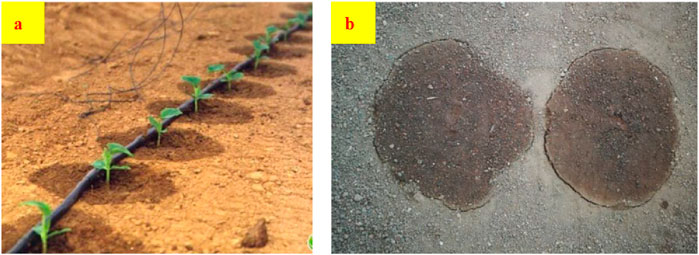
Figure 1. Pictures of drip irrigation (a) and soil crusts and desiccation cracks (b) (note: picture “a” provided by T.W. Lei).
Soil crusts play a significant role in influencing soil erosion. Previous studies have demonstrated that soil crusts reduce water infiltration, increase surface runoff, and decrease sediment yield during rainfall events (Bradford et al., 1987; Wang et al., 2016). Ries and Hirt (2008) highlighted the relationship between rill erosion and soil crusts on fallow lands, attributing this connection to the hydrodynamic forces induced by crust formation. Furthermore, based on research conducted in the Loess Plateau of China, Algayer et al. (2014) emphasized that soil inter-rill erodibility is significantly influenced by the presence of soil crusts. They recommended integrating soil crust characteristics into soil erosion models to enhance the accuracy of erosion predictions. However, the soil crusts examined in these studies were formed under simulated or natural rainfall conditions, leaving a critical gap in understanding crust formation under drip irrigation conditions. The formation mechanisms of crusts under rainfall involve the impact of raindrops on soil particles, which disrupt soil aggregates and reduce soil structure stability (Robinson and Woodun, 2008; Han et al., 2016). In contrast, under drip irrigation, soil particles are not exposed to the erosive force of raindrops, resulting in less disturbance to soil structure. Instead, crust formation under drip irrigation is primarily attributed to the evaporation of soil water (Chamizo et al., 2013; Zhang et al., 2013; Jia et al., 2021). Specifically, the soil within the drip irrigation zone typically retains higher moisture content than the surrounding areas. As the soil water evaporates, the surface layer hardens, leading to the development of circular crusts and desiccation cracks (Figure 1b). These features may exhibit distinct hydrological responses to subsequent rainfall compared to crusts formed under rainfall conditions.
The preceding discussion underscores a notable research gap: the potential impact of circular crusts and desiccation cracks formed after drip irrigation on soil erosion remains unexplored. This study aims to address this gap by conducting rainfall simulation experiments to quantify soil erosion rates at different drying intervals following drip irrigation. The primary objective is to investigate how drip irrigation-formed crusts and cracks influence soil erosion dynamics and provide insights into the broader implications of drip irrigation practices on soil conservation.
2 Materials and methods
2.1 Study area
This study was conducted in the Huaxi district (26°26′18.23″N, 106°39′45.32″E) located in Guizhou province, China. The region exhibits a subtropical humid climate characterized by a mean annual temperature of 14.9°C. The mean annual precipitation is approximately 1,100 mm, which is unevenly distributed throughout the year. Most rainfall occurs between July and September, while the period from April to June often experiences a rainfall shortage during the growing season. Additionally, the study area is part of a karst landscape, where the extensive development of underground river networks results in low groundwater retention capacity at the surface. These climatic and geomorphological characteristics contribute to frequent seasonal drought in the region (Wang et al., 2012). Consequently, the adoption of water-saving drip irrigation technology presents an effective solution to address agricultural water scarcity.
2.2 Soils
The experimental soils were collected from sloping land and classified as yellow soil according to the Chinese soil taxonomy system. According to the World Reference Base for Soil Resources (WRB) classification system, this soil type corresponds to Xanthic Ferralsols, characterized as silty clay loam. The soil exhibits a granular structure with a very loose texture, which makes it highly susceptible to erosion. This area experiences significant annual soil loss, leading to severe land degradation and rocky desertification (Wang et al., 2004). The fundamental physicochemical properties of the soil are presented in Table 1.
2.3 Experimental setup and equipment description
2.3.1 Soil box configuration
The experiments were conducted in a controlled rainfall simulation laboratory, and the experimental setup and associated equipment are illustrated in Figure 2. The soil boxes were constructed with dimensions of 1.0 m (length) × 0.5 m (width) × 0.12 m (depth). Since land with a slope greater than 15° accounts for more than 70% of the study area, the soil box surface was sloped at a 15° angle to simulate realistic field conditions. A V-shaped drainage outlet was installed at the downslope end of the box to facilitate the collection of surface runoff and sediment transport. Additionally, eight drainage holes (5 mm in diameter) were positioned at the base of the soil box to allow for free drainage of infiltrating water during rainfall events.
2.3.2 Rainfall simulator
The rainfall simulation apparatus was equipped with two side-spray nozzles, which generated raindrops with a kinetic energy impact rate equivalent to 80% of that observed during natural rainstorms at comparable intensities. This simulator has been extensively used for soil erosion studies across multiple research institutions over several decades, and its detailed specifications have been documented in previous studies (Zhao et al., 2018). Before starting the experiments, the rainfall intensity of the simulator was calibrated to match the target intensity of 90 mm/h, which is commonly used in simulated rainfall experiments to create fast runoff and sediment on the surface. The position of the rainfall simulator was maintained consistently throughout all tests to preserve the uniformity of rainfall conditions.
2.3.3 Drip irrigation simulation apparatus
The drip irrigation system consisted of a water tank, a connecting pipe, and several drippers (Figure 2). For this study, the drippers were replaced with an infusion set to better replicate real-world conditions. During the experiments, needles were vertically inserted into the soil, and water was pumped from the water tank through the connecting pipe. The drip discharge rate was regulated using a flow regulator attached to the connecting pipe. Notably, the process of simulating drip irrigation closely resembled clinical transfusion techniques. In this study, each “wetted circle” was created using 500 mL of water, with a drip discharge rate of approximately 25 mL/min per needle.
2.4 Experiment treatments and procedures
2.4.1 Experiment treatments
To investigate the effects of drip irrigation on soil erosion, this study employed three rainfall treatments applied to soils following drip irrigation: 1) rainfall was applied 24 h after drip irrigation (S24); 2) rainfall was applied 48 h after drip irrigation (S48), and 3) rainfall was applied 72 h after drip irrigation (S72). A surface without prior drip irrigation served as the control measure (S0). Specifically, the S0 treatment was not pre-wetted, thereby preventing the formation of crusts and cracks on the surface prior to conducting the rainfall experiments. This allows for a more accurate comparison with drip irrigation treatments in order to emphasize the effects of drip irrigation on erosion.
2.4.2 Soil preparation
The soil samples were air-dried under ambient conditions in the laboratory and adjusted to maintain a moisture content of approximately 7%. Aggregated soil clods were manually crushed using a spade, and plant residues and gravel were removed using a 5-mm sieve to ensure particle homogeneity. The soil density within the soil boxes was maintained at 1.15 g/cm3, with a uniform soil depth of 10 cm. After filling the boxes, the soil surface was carefully leveled using a wooden board to ensure consistency across all experimental setups.
2.4.3 Drip irrigation simulation
The drip irrigation simulation apparatus was positioned above the soil boxes, with six dripping devices arranged at intervals of 25 cm × 25 cm across the soil surface. Each device was equipped with a needle inserted into the soil, and a flow regulator was used to maintain a constant water infiltration rate of approximately 25 mL/min. An amount of 500 mL of water was introduced into each bottle, and the system was allowed to operate until complete infiltration occurred. Following the completion of the drip irrigation simulation, the soil boxes were undisturbed for 24, 48, or 72 h depending on the treatment.
2.4.4 Rainfall simulation and data collection
Rainfall simulations were conducted in a controlled environment for a total rainfall duration of 60 min for all treatments to ensure the attainment of a steady state for runoff measurements. During the rainfall event, surface runoff and sediment were collected at 2-min intervals using 1-L plastic buckets. Immediately following the cessation of rainfall, the weights of the collected samples were recorded. The buckets were then stored at an indoor temperature for approximately 24 h to allow the settling of sediment. After this period, the supernatant water was decanted, and the sediment was transferred to steel cups for further processing.
The sediment samples were oven-dried at 105°C for 8 h to achieve complete desiccation. Once dried, the sediments were weighed to determine their final mass. These data were subsequently used to calculate runoff volume and sediment yield for each treatment.
2.4.5 Statistical analysis
Each experimental trial was repeated three times to ensure the reliability and reproducibility of the results. The differences in runoff and sediment yields among the treatments were statistically analyzed using Fisher’s least significant difference (LSD) test to identify significant variations between treatments.
3 Results and discussion
3.1 Surface runoff
The temporal variation in runoff rates across the four rainfall treatments is shown in Figure 3. Compared to that in the S0 treatment, the initial runoff time was delayed by 3–5 min for the S24, S48, and S72 treatments. Analysis of the runoff dynamics revealed minor differences between the S0 and S24 treatments, whereas major discrepancies were observed between the S0 and both the S48 and S72 treatments. For all experimental conditions, the runoff rate achieved a steady state approximately 10 min after the initiation of runoff. The corresponding steady-state runoff rates of the S0, S24, S48, and S72 treatments were 6.64, 6.59, 4.53, and 4.71 g/s, respectively. Notably, the steady-state runoff rates for the S48 and S72 treatments were significantly lower than those observed for the S0 and S24 treatments. These results suggested that the duration of soil drying following drip irrigation significantly influences the soil’s hydrological response to subsequent rainfall events. Specifically, longer periods of soil desiccation appear to alter the water infiltration, potentially impacting rainfall-runoff processes.
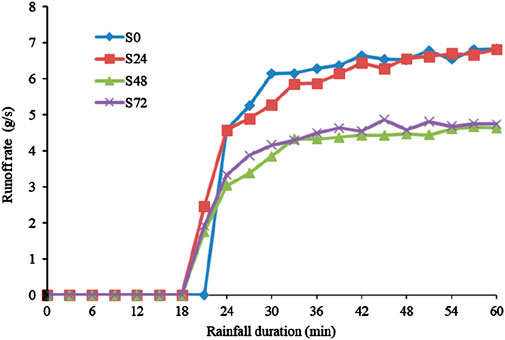
Figure 3. Temporal variation in runoff rates under different experimental treatments during a 60-min rainfall event (S0, surface without drip irrigation; S24, rainfall applied 24 h after drip irrigation; S48, rainfall applied 48 h after drip irrigation; S72, rainfall applied 72 h after drip irrigation).
To further investigate the effect of drip irrigation on rainfall-runoff processes, the total runoff yields were quantified for the four rainfall treatments during a 60-min rainfall event (Figure 4). Significant differences in the total runoff yields were observed among the treatments. The S24 treatment had the greatest total runoff yield (16.88 kg), followed closely by the S0 treatment (15.16 kg). The total runoff yields for the S48 and S72 treatments were notably lower at 11.45 kg and 11.84 kg, respectively. Statistical analysis revealed no significant differences (p > 0.05) in the total runoff yields between the S48 and S72 treatments. These patterns observed in the total runoff yields are consistent with the trends in steady-state runoff rates reported in Figure 3, highlighting a strong relationship between soil drying duration and rainfall-runoff dynamics. These findings demonstrate that the timing of rainfall application relative to prior drip irrigation significantly influenced the total runoff yields. The greater total runoff yields observed for the S0 and S24 treatments may reflect differences in soil moisture content and soil crust properties formed by the varying durations of drying following drip irrigation. On the other hand, the lower runoff yields for the S48 and S72 treatments suggest that prolonged soil desiccation after irrigation altered the soil’s hydrological behavior, potentially reducing its runoff-generating capacity during subsequent rainfall events. These results emphasize the importance of considering antecedent soil moisture contents when evaluating hydrological responses to rainfall events in agricultural systems.
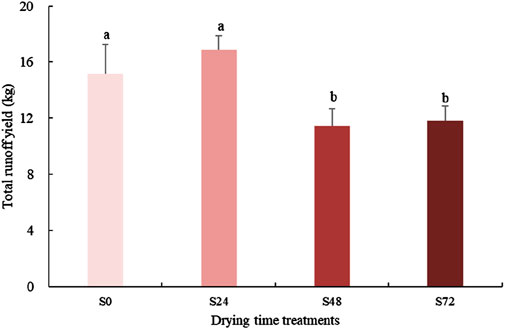
Figure 4. Total runoff yields under different experimental treatments during a 60-min rainfall event (S0, surface without drip irrigation; S24, rainfall applied 24 h after drip irrigation; S48, rainfall applied 48 h after drip irrigation; S72, rainfall applied 72 h after drip irrigation; bar represents standard deviation (n = 3); different letters indicate significantly different means based on Fisher’s least significant difference F test at p < 0.05).
The observed results may be attributed to water evaporation from the soil surface following drip irrigation. As illustrated in Figure 1, drip irrigation supplies water directly to crop roots, resulting in localized infiltration within a small circular area around the root zone. Over time, evaporation causes soil moisture loss in the drip-irrigated area, leading to soil hardening and the formation of a physical crust (Wang et al., 2016). Furthermore, as time progresses, desiccation cracks begin to develop around the hardened soil area. These soil changes significantly influence the hydrological response of the entire surface during rainfall-runoff processes. Specifically, after 24 h of drip irrigation, soil moisture has not yet been fully lost, and no desiccation cracks have formed in the drip-irrigated area. Consequently, the soil surface remains relatively intact, facilitating runoff generation during rainfall. This explains the high total runoff yield observed in the S24 treatment. In this case, the initial soil moisture content within the drip-irrigated area is sufficiently high to reduce the average infiltration rate and increase the runoff rate during rainfall events. However, after 48 h of drip irrigation, the soil becomes dry, and a soil crust of moderate intensity forms in the drip-irrigated area. Simultaneously, desiccation cracks begin to develop around the drip-irrigated zone due to soil shrinkage caused by water loss. During rainfall, a significant portion of rainwater infiltrates into the soil through these desiccation cracks, resulting in reduced total runoff. This explains why the total runoff yields for the S48 and S72 treatments are lower than those for the S0 and S24 treatments. These findings align with a previous study on the effects of soil drying on runoff and sediment dynamics on crusted soils (Zhang and Miller, 1993). On the other hand, many studies have demonstrated that soil crusts can significantly reduce soil infiltration rates, thereby enhancing runoff production (Bradford et al., 1987; Magunda et al., 1997; Wang et al., 2016). Based on these studies, one might expect that the S48 and S72 treatments would exhibit lower runoff yields than the S0 treatment. However, this expectation is not entirely consistent with our observation. We did not consider this a contradiction because soil crusts formed under rainfall conditions are primarily caused by the impact of raindrops, which disperse soil particles to disperse and compact the soil surface, creating a thin and dense layer (Jakab et al., 2013). In contrast, under drip irrigation conditions, soil particles are not subjected to raindrop impact, meaning that the soil structure remains undisturbed. Additionally, the crusts formed by drip irrigation are more easily rehydrated upon subsequent water supplication, allowing for greater infiltration and reduced generation. Therefore, in the case of soils with prolonged drying periods following drip irrigation, the presence of desiccation cracks facilitates increased infiltration and reduces surface runoff during rainfall events. This observation is consistent with the findings reported by Cheng and Cai (2013), who noted that the reduction in infiltration caused by soil crusts is out-weighted by the increase in filtration due to desiccation cracks.
3.2 Sediment
The sediment rates and total sediment yields are critical indicators for evaluating soil erosion dynamics across various experimental treatments. Sediment transport is facilitated by surface runoff, with sediment generation occurring nearly simultaneously with runoff initiation. Unlike the relatively straightforward evolution of the runoff dynamic curves, the sediment production process is more intricate and dynamic. As depicted in Figure 5, the sediment rate exhibits continuous fluctuations throughout the rainfall period once surface runoff begins, reflecting the complex interplay of hydrological and erosional processes. This phenomenon is primarily due to the nonlinear nature of sediment generation and transport processes (Esteves et al., 2000; Kuhn and Bryan, 2004). In other words, the sediment rate does not necessarily increase with an increase in surface runoff, but it depends on near-surface characteristics such as micro-reliefs (Darboux and Huang, 2005; Zhao et al., 2026). Crusts and cracks in drip-irrigated and unirrigated areas have different responses to water infiltration and rainfall-runoff processes, leading to variations in the anti-erosion ability of the entire surface (Ben-Hur and Lado, 2008; Robinson and Woodun, 2008; Han et al., 2016).
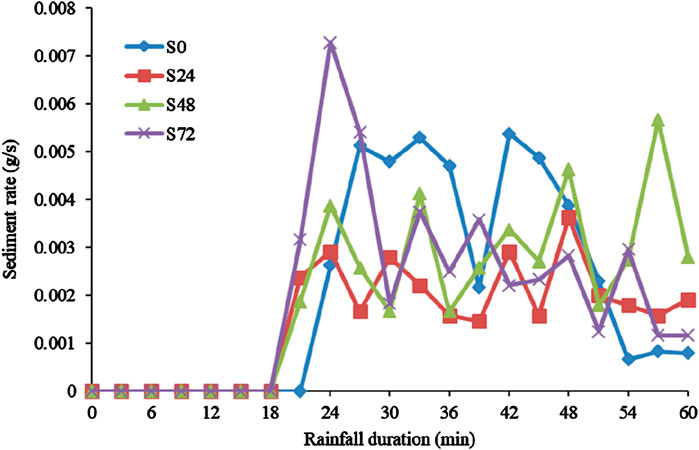
Figure 5. Sediment rate curves under different experimental treatments during a 60-min rainfall event (S0, surface without drip irrigation; S24, rainfall applied 24 h after drip irrigation; S48, rainfall applied 48 h after drip irrigation; S72, rainfall applied 72 h after drip irrigation).
For the S0 treatment, the sediment rate exhibits an initial increase, followed by a subsequent decrease, and ultimately stabilizes after approximately 50 min of rainfall. During this period, a single notable decrease in the sediment rate occurred at approximately the 38-min mark. In contrast, for the other three treatments involving drip irrigation (S24, S48, and S72), the sediment rate experienced multiple fluctuations throughout the rainfall duration, and no clear steady state was observed until the conclusion of the rainfall event. This discrepancy suggests that the mechanisms governing sediment production differ significantly between soils with drip irrigation-formed crusts and those without such crusts (Kuhn and Bryan, 2004).
As illustrated in Figure 6, the total sediment yields varied considerably among the four treatments. Compared to the S0 treatment, the sediment yields for the S24, S48, and S72 treatments were reduced by 37.59%, 19.71%, and 15.70%, respectively. This reduction can be attributed to the lower surface runoff observed in the S48 and S72 treatments relative to the S0 treatment. Interestingly, despite the S24 treatment having the highest runoff rate among all treatments, it exhibited the lowest sediment yield. This phenomenon can be explained by the presence of a soil crust within the drip irrigation area, which mitigated soil erosion during runoff events, consequently reducing the sediment yield compared to that of the S0 treatment. The elevated sediment yields observed for the S48 and S72 treatments compared to the S24 treatment may be linked to the influence of desiccation cracks on the soil erosion process. Post-rainfall observations revealed the formation of circular rills around the drip irrigation area in these treatments (Figure 7). These rills, characterized by relatively low heights compared to their surroundings, were absent in the S24 treatment. For the S0 treatment, an obvious flow path was formed after rainfall, whereas no such flow paths were observed on the surface of the S48 and S72 treatments due to the impact of the desiccation cracks. This indicates that the presence of desiccation cracks can influence both runoff dynamics and sediment transport pathways, ultimately affecting the total sediment yields.
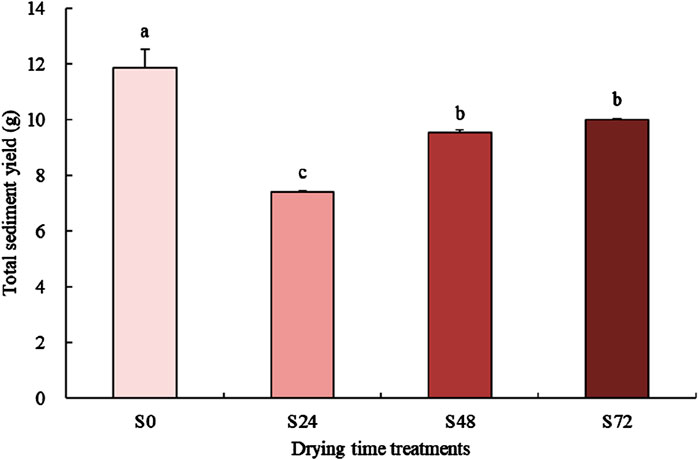
Figure 6. Total sediment yields under different experimental treatments during a 60-min rainfall event (S0, surface without drip irrigation; S24, rainfall applied 24 h after drip irrigation; S48, rainfall applied 48 h after drip irrigation; S72, rainfall applied 72 h after drip irrigation; bar represents standard deviation (n = 3); different letters indicate significantly different means based on Fisher’s least significant difference F test at p < 0.05).
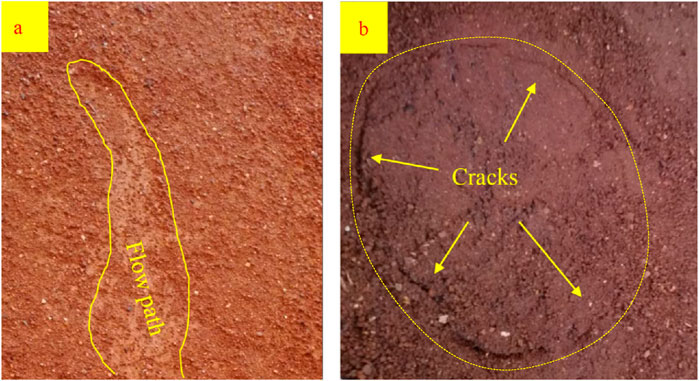
Figure 7. Surface change under different experimental treatments during a 60-min rainfall event: (a) soil surface without drip irrigation application before rainfall facilitates the production of a flow path; (b) soil surface with drip irrigation application before rainfall, and a dotted yellow line showing signs of desiccation cracks.
4 Conclusion
Drip irrigation is a highly effective method for conserving water in agricultural practices. Over the past several years, research into the effects of drip irrigation on soil infiltration and vegetation reconstruction has flourished. However, no study has systematically investigated its impact on soil erosion as it is generally assumed that drip irrigation does not directly contribute to soil erosion. In this study, we conducted a preliminary investigation and concluded that drip irrigation can reduce soil erosion due to the formation of soil crusts and desiccation cracks. Interestingly, if rainfall occurs shortly after drip irrigation, it leads to increased surface runoff. Conversely, after 48 h of drip irrigation, a greater amount of rainwater infiltrates into the soil. These findings highlight the dual role of drip irrigation in both conserving water and influencing soil erosion dynamics, emphasizing the need for further research to provide a deeper understanding of the mechanisms underlying soil erosion in drip-irrigated soils. In this study, only one level of rainfall intensity and slope degree is applied, and the range of rainfall intensity should be expanded in future experiments to make the research results more representative. Furthermore, to better explain the mechanisms between drip irrigation-formed soil crusts and water erosion, it is necessary to quantitatively analyze the physical properties of soil crusts, such as thickness, compaction, and infiltration.
In summary, these findings highlight the complex interplay between soil crust formation, desiccation cracking, and sediment production under varying antecedent soil moisture conditions induced by drip irrigation. The results underscore the importance of considering soil structural changes when evaluating erosion processes in agricultural systems.
Data availability statement
The raw data supporting the conclusions of this article will be made available by the authors, without undue reservation.
Author contributions
JZ: Conceptualization, Data curation, Writing – original draft. DZ: Data curation, Formal analysis, Writing – review and editing. BZ: Data curation, Formal analysis, Methodology, Writing – review and editing. SZ: Formal analysis, Methodology, Writing – review and editing. ZH: Writing – review and editing, Funding acquisition.
Funding
The author(s) declare that financial support was received for the research and/or publication of this article. This study was financially supported by the Fundamental Research Funds for Central Non-profit Research Institutes (CAFYBB2023ZA009-03), the China Power Construction Group Key Technology R&D Program (DJ-ZDXM-2023-07-01), and the Guiyang Science and Technology R&D Program (ZK202348-15).
Conflict of interest
Authors DZ, BZ, and SC were employed by PowerChina Guiyang Engineering Corporation Limited.
The remaining authors declare that the research was conducted in the absence of any commercial or financial relationships that could be construed as a potential conflict of interest.
Generative AI statement
The author(s) declare that no Generative AI was used in the creation of this manuscript.
Publisher’s note
All claims expressed in this article are solely those of the authors and do not necessarily represent those of their affiliated organizations, or those of the publisher, the editors and the reviewers. Any product that may be evaluated in this article, or claim that may be made by its manufacturer, is not guaranteed or endorsed by the publisher.
References
Algayer, B., Wang, B., Bourennane, H., Zheng, F., Duval, O., Li, G., et al. (2014). Aggregate stability of a crusted soil: differences between crust and sub-crust material, and consequences for interrill erodibility assessment. An example from the Loess Plateau of China. J. Soil Sci. 65, 325–335. doi:10.1111/ejss.12134
Al-Ghobari, H. M., and Dewidar, A. Z. (2018). Integrating deficit irrigation into surface and subsurface drip irrigation as a strategy to save water in arid regions. Agric. Water Manag. 209, 55–61. doi:10.1016/j.agwat.2018.07.010
Ben-Hur, A., and Lado, M. (2008). Effect of soil wetting conditions on seal formation, runoff, and soil loss in arid and semiarid soils—a review. Aust. J. Soil Res. 46, 191–202. doi:10.1071/sr07168
Beser, N., Surek, H., Sahin, S., Kaya, R., Tuna, B., and Cakir, R. (2016). An investigation of various drip irrigation treatments in rice (Oryza sativa L.). Fresenius Environ. Bull. 25, 3680–3686.
Bradford, J. M., Ferris, J. E., and Remley, P. A. (1987). Interrill soil erosion processes: I. Effect of surface sealing on infiltration, runoff, and soil splash detachment. Soil Sci. Soc. Am. J. 51, 1566–1571. doi:10.2136/sssaj1987.03615995005100060029x
Chamizo, S., Cantón, Y., Domingo, F., and Belnap, J. (2013). Evaporative losses from soils covered by physical and different types of biological soil crusts. Hydrol. Process. 27, 324–332. doi:10.1002/hyp.8421
Chamizo, S., Cantón, Y., Miralles, I., and Domingo, F. (2012). Biological soil crust development affects physicochemical characteristics of soil surface in semiarid ecosystems. Soil Biol. and Biochem. 49, 96–105. doi:10.1016/j.soilbio.2012.02.017
Cheng, Q. J., and Cai, Q. G. (2013). Response of soil surface crusts on soil erosion in loess under simulated rainfalls. J. Soil Water Conservation 27, 73–77. (in Chinese with English abstract) doi:10.13870/j.cnki.stbcxb.2013.04.029
Darboux, F., and Huang, C. (2005). Does soil surface roughness increase or decrease water and particle transfers? Soil Sci. Soc. Am. J. 69, 748–756. doi:10.2136/sssaj2003.0311
Esteves, M., Faucher, X., Galle, S., and Vauclin, M. (2000). Overland flow and infiltration modelling for small plots during unsteady rain: numerical results versus observed values. J. Hydrology 228, 265–282. doi:10.1016/s0022-1694(00)00155-4
Evans, J. P., and Zaitchik, B. F. (2008). Modeling the large-scale water balance impact of different irrigation systems. Water Resour. Res. 44, 370–380. doi:10.1029/2007wr006671
Han, Y., Fan, Y., Xin, Z., Wang, L., Cai, Q., and Wang, X. (2016). Effects of wetting rate and simulated rain duration on soil crust formation of red loam. Environ. Earth Sci. 75, 149–158. doi:10.1007/s12665-015-4901-x
Hardie, M., and Almajmaie, A. (2019). Measuring and estimating the hydrological properties of a soil crust. J. Hydrology 574, 12–22. doi:10.1016/j.jhydrol.2019.04.031
Jakab, G., Németh, T., Csepinszky, B., Madarasz, B., Szalai, Z., and Kertesz, A. (2013). The influence of short term soil sealing and crusting on hydrology and erosion at balaton uplands, Hungary. Carpathian J. Earth and Environ. Sci. 8, 147–155. doi:10.1016/j.wasman.2012.12.019
Jia, Q., Shi, H., Li, R., Miao, Q., Feng, Y., Wang, N., et al. (2021). Evaporation of maize crop under mulch film and soil covered drip irrigation: field assessment and modelling on West Liaohe Plain, China. Agric. Water Manag. 253, 106894. doi:10.1016/j.agwat.2021.106894
Khan, S., Abbas, A., Gabriel, H. F., Rana, T., and Robinson, D. (2008). Hydrologic and economic evaluation of water-saving options in irrigation systems. Irrigation and Drainage 57, 1–14. doi:10.1002/ird.336
Kuhn, N. J., and Bryan, R. B. (2004). Drying, soil surface condition and interrill erosion on two Ontario soils. Catena 57, 113–133. doi:10.1016/s0341-8162(03)00242-x
Laker, M. C., and Nortje, G. P. (2019). Review of existing knowledge on soil crusting in South Africa. Adv. Agron. 155, 189–242. doi:10.1016/bs.agron.2019.01.002
Li, X. B., Kang, Y. H., Wan, S. Q., Chen, X. L., Chu, L. L., and Xu, J. C. (2015). First and second-year assessments of the rapid reconstruction and re-vegetation method for reclaiming two saline-sodic, coastal soils with drip-irrigation. Ecol. Eng. 84, 496–505. doi:10.1016/j.ecoleng.2015.09.004
Magunda, M. K., Larson, W. E., Linden, D. R., and Nater, E. A. (1997). Changes in microrelief and their effects on infiltration and erosion during simulated rainfall. Soil Technol. 10, 57–67. doi:10.1016/0933-3630(95)00039-9
Najafabadi, M. A., Nafchi, R. F., Salami, H., Vanani, H. R., and Ostad-Ali-Askari, K. (2023). Effect of different managements with drip irrigation (tape). Appl. Water Sci. 13, 37. doi:10.1007/s13201-022-01847-5
Ries, J. B., and Hirt, U. (2008). Permanence of soil surface crusts on abandoned farmland in the Central Ebro Basin/Spain. Catena 72, 282–296. doi:10.1016/j.catena.2007.06.001
Robinson, D. A., and Woodun, J. K. (2008). An experimental study of crust development on chalk downland soils and their impact on runoff and erosion. Eur. J. Soil Science59 59, 784–798. doi:10.1111/j.1365-2389.2008.01033.x
Singh, R., Kumar, S., Nangare, D. D., and Meena, M. S. (2009). Drip irrigation and black polyethylene mulch influence on growth, yield and water-use efficiency of tomato. Afr. J. Agric. Res. 4, 1427–1430.
Stark, J. C., Love, S. L., King, B. A., Marshall, J. M., Bohl, W. H., and salaiz, T. (2013). Potato cultivar response to seasonal drought patterns. Am. J. Potato Res. 90, 207–216. doi:10.1007/s12230-012-9285-9
Van Donk, S. J., and Shaver, T. M. (2016). Effects of nitrogen application frequency via subsurface drip irrigation on corn development and grain yield. J. Plant Nutr. 39, 1830–1839. doi:10.1080/01904167.2016.1143506
Wang, J., Watts, D. B., Meng, Q., Zhang, Q. F., and Way, T. R. (2016). Influence of surface crusting on infiltration of a Loess Plateau soil. Soil Sci. Soc. Am. J. 80, 683–692. doi:10.2136/sssaj2015.08.0291
Wang, M., Wang, X., Huang, W., Zhang, Y., and Ma, J. (2012). Temporal and spatial distribution of seasonal drought in Southwest of China based on relative moisture index. Trans. CSAE 28, 85–92. (in Chinese with English abstract) doi:10.3969/j.issn.1002-6819.2012.19.012
Wang, S. J., Liu, Q. M., and Zhang, D. F. (2004). Karst rocky desertification in southwestern China: geomorphology, landuse, impact and rehabilitation. Land Degrad. and Dev. 15, 115–121. doi:10.1002/ldr.592
Xiao, X., Zhao, Y. W., and Hu, F. (2008). Comparison of the function of different water-saving rice cultivation systems in the seasonal-drought hilly region of southern China. J. Sustain. Agric. 32, 463–482. doi:10.1080/10440040802257462
Yahyaoui, I., Tadeo, F., and Segatto, M. V. (2016). Energy and water management for drip-irrigation of tomatoes in a semi-arid district. Agric. Water Manag. 183, 4–15. doi:10.1016/j.agwat.2016.08.003
Yang, P., Wu, L., Cheng, M., Fan, J., Li, S., Wang, H., et al. (2023). Review on drip irrigation: impact on crop yield, quality, and water productivity in China. Water 15, 1733. doi:10.3390/w15091733
Zhang, G., Liu, C., Xiao, C., Xie, R., Ming, B., Hou, P., et al. (2017). Optimizing water use efficiency and economic return of super high yield spring maize under drip irrigation and plastic mulching in arid areas of China. Field Crops Res. 211, 137–146. doi:10.1016/j.fcr.2017.05.026
Zhang, J. G., Xu, X. W., Lei, J. Q., Li, S. Y., Hill, R. L., and Zhao, Y. (2013). The effects of soil salt crusts on soil evaporation and chemical changes in different ages of Taklimakan Desert Shelterbelts. J. Soil Sci. Plant Nutr. 13, 0–1028. doi:10.4067/s0718-95162013005000080
Zhang, X. C., and Miller, W. P. (1993). The effect of drying on runoff and interrill erosion of crusted soils. Catena Suppl. 24, 103–144.
Zhao, L. S., Hou, R., Wu, F. Q., and Keesstra, S. (2018). Effect of soil surface roughness on infiltration water, ponding and runoff on tilled soils under rainfall simulation experiments. Soil and Tillage Res. 179, 47–53. doi:10.1016/j.still.2018.01.009
Keywords: drip irrigation, soil crusting, desiccation cracks, runoff, sediment
Citation: Zhang J, Zhang D, Zhang B, Zeng S and Han Z (2025) Response of soil erosion to rainfall during different dry periods following drip irrigation. Front. Environ. Sci. 13:1526066. doi: 10.3389/fenvs.2025.1526066
Received: 11 November 2024; Accepted: 09 May 2025;
Published: 30 May 2025.
Edited by:
Narsimha Adimalla, East China University of Technology, ChinaReviewed by:
Velibor Spalevic, University of Montenegro, MontenegroTianyang Li, Southwest University, China
Copyright © 2025 Zhang, Zhang, Zhang, Zeng and Han. This is an open-access article distributed under the terms of the Creative Commons Attribution License (CC BY). The use, distribution or reproduction in other forums is permitted, provided the original author(s) and the copyright owner(s) are credited and that the original publication in this journal is cited, in accordance with accepted academic practice. No use, distribution or reproduction is permitted which does not comply with these terms.
*Correspondence: Jinxin Zhang, emhhbmdfamluX3hpbkAxNjMuY29t; Zhen Han, emhhbkBnenUuZWR1LmNu
 Jinxin Zhang1,2*
Jinxin Zhang1,2*
